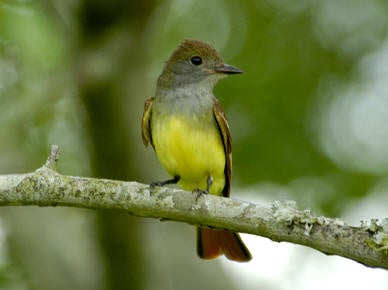SCIENTIFIC NAME:
Myiarchus crinitus
STATUS:
Breeder. Common in spring, summer, and fall in all regions. Lowest Conservation Co
DESCRIPTION:
The great crested flycatcher belongs to the family Tyrannidae, the New World flycatchers. It is one of 17 species of flycatchers regularly found in eastern North America. The great crested flycatcher is olive brown above with a gray chest and yellow belly. The wings and tail are a cinnamon color, and the wings have white bars. It has a short fluffy crest that is raised when it is excited. Males and females have similar plumage. It is one of the larger flycatchers, with a length of seven to eight inches, a wingspan of about 13 inches and a weight of one to one and a half ounces.
DISTRIBUTION:
The breeding range of the great crested flycatcher extends from southern Alberta across southern Canada to Nova Scotia, and south across the United States from Texas to Florida. The winter range is southern Mexico, Central America, and northern South America. Some birds also winter in southern Florida.
HABITAT:
The great crested flycatcher is found in deciduous or mixed woodlands across its summer range, and winters in humid forests and second growth. It also breeds in old orchards, as well as in parks and urban areas with large shade trees.
FEEDING HABITS:
The great crested flycatcher feeds on insects, other invertebrates, and small fruits. Hunting from a high, shady perch, it flies out to capture flying insects, hence its name, flycatcher. Sometimes it may drop from its perch to take insects on the ground, or hover to glean insects from leaves.
LIFE HISTORY AND ECOLOGY:
The spring arrival of the great crested flycatcher is often signaled by the bird’s harsh ascending “whreeep” call from high in a tree. Unlike other flycatchers that breed in eastern North America, the great crested flycatcher builds its nest in a natural cavity of a tree, or sometimes a cavity in a log, stump, or rotten fencepost. They will also use a nest box, mailbox, or newspaper box. The nest is built of grasses, leaves, needles, twigs, and feathers. A curious habit is the placing of shed snakeskin, or maybe just a piece of cellophane, in many of the nests. Both the male and female construct the nest. Both sexes vigorously defend the nest from other flycatchers, birds and squirrels. The female usually lays five brown-streaked, creamy white eggs that are incubated for about two weeks. Hatchlings stay in the nest for two weeks or a little longer before fledging. The family may remain together during the summer and migrate as a group, but they do not associate with other flycatcher families.
The great crested flycatcher is mostly a bird of the tree canopy and spends little time on the ground. It does not walk when on the ground, preferring to fly from place to place. It is an active and aggressive bird that moves swiftly from its perch to capture insects or attack smaller birds that approach it. Among themselves, the birds have fierce encounters when one enters another’s territory. It attacks its prey with zeal and flies back to its perch, often beating the insect on a branch before swallowing it. Its demeanor is in keeping with its family name Tyrannidae, the tyrannical flycatchers.
REFERENCES:
Robbins, C. S., B. Bruun, and H. S. Zim. Birds of North America. Golden Press, Racine, WI, 340pp.
Welty, J. C. 1975. The Life of Birds. W. B. Saunders, Philadelphia, PA, 623pp.
AUTHOR:
Stanley D. Stewart, Wildlife Biologist, Alabama Wildlife and Freshwater Fisheries






